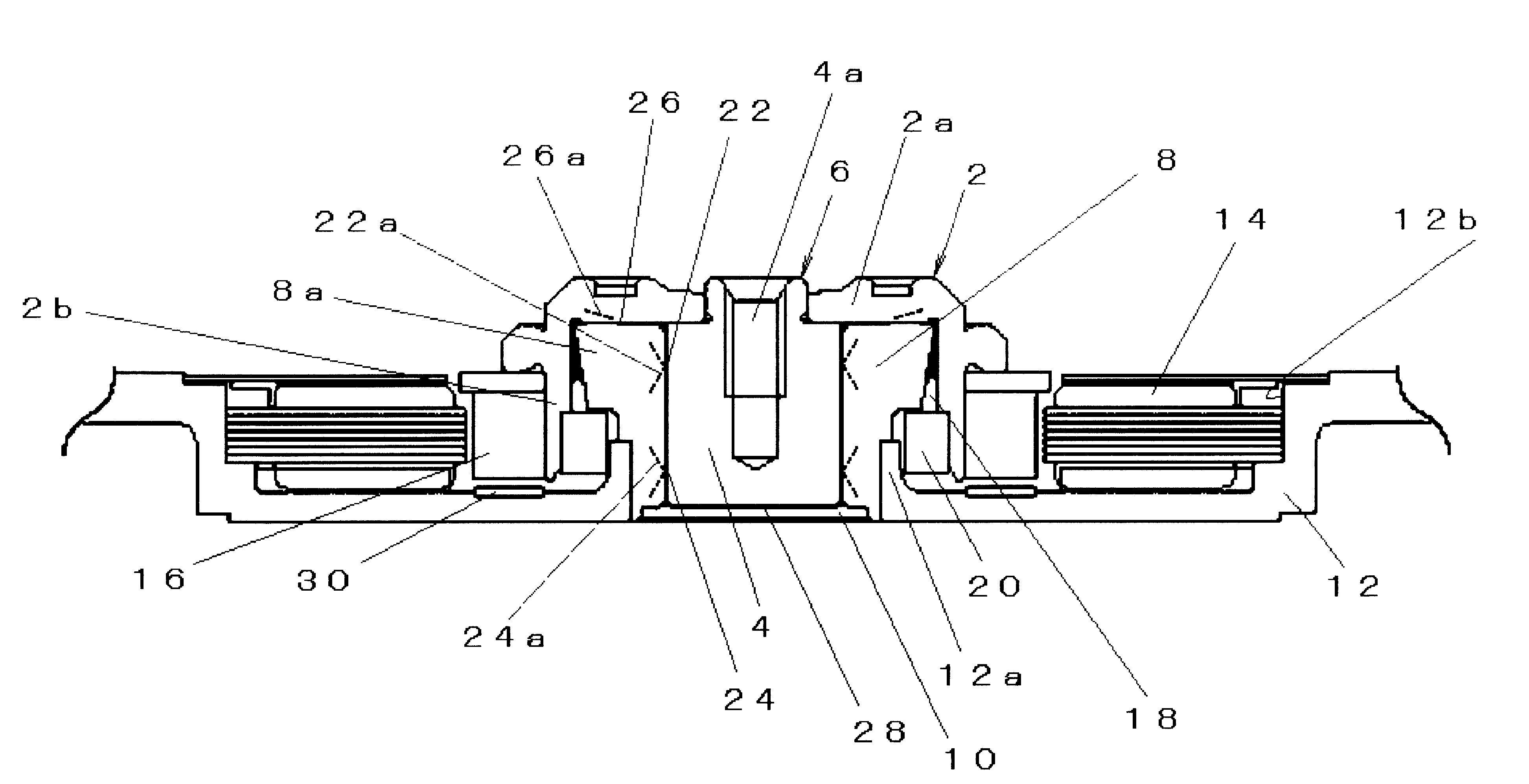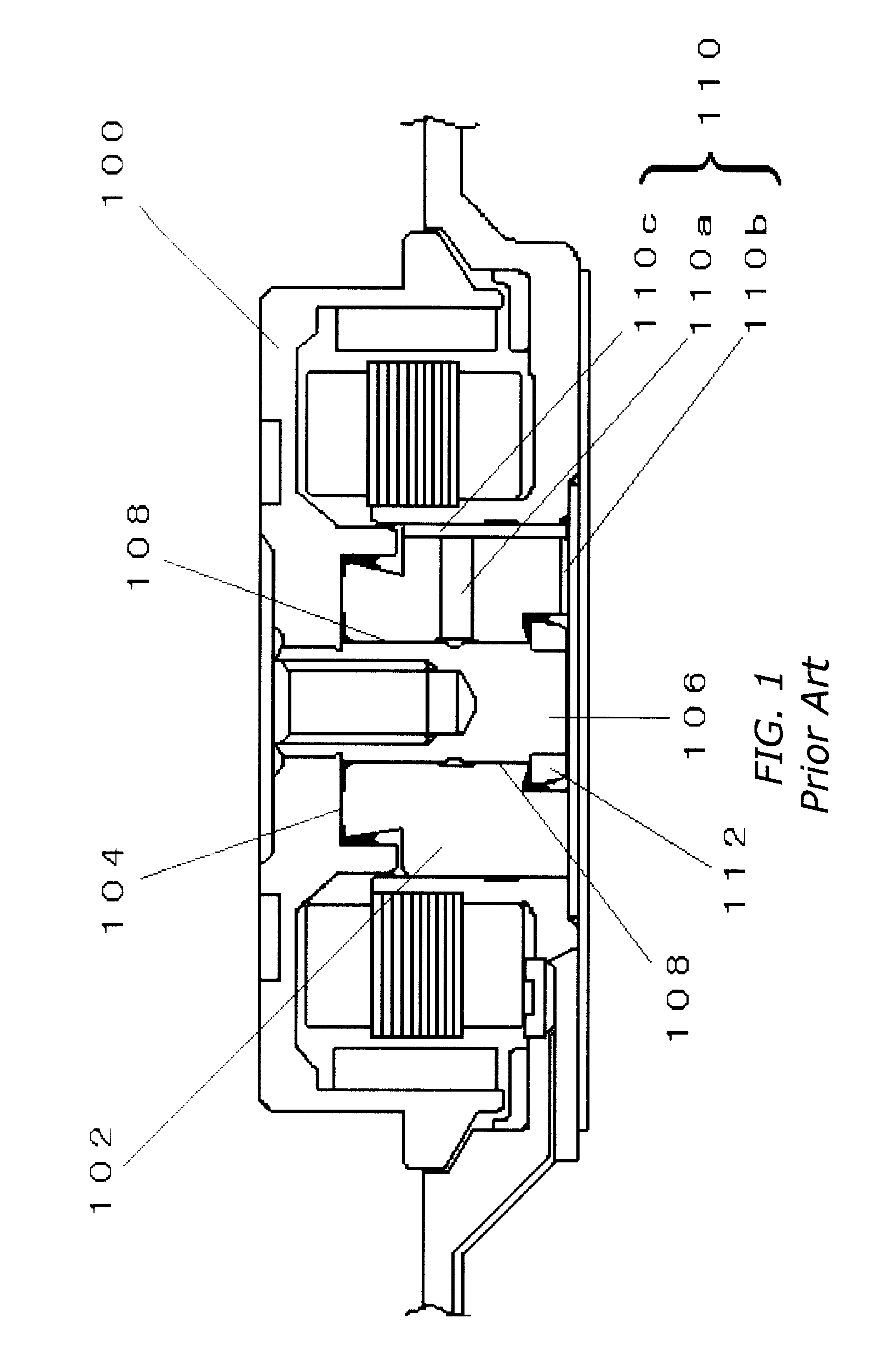Spindle motor and disk drive utilizing the spindle motor
- Summary
- Abstract
- Description
- Claims
- Application Information
AI Technical Summary
Benefits of technology
Problems solved by technology
Method used
Image
Examples
modification example 1
[0081] (6-1) Modification Example 1
[0082] In the modification example diagrammed in FIG. 8A herringbone grooves 22a# formed in an upper radial bearing section 22# have an asymmetrical configuration in the axial direction, while the herringbone grooves 24a formed in the lower radial bearing section 24 have a symmetrical configuration with respect to where they join, likewise as is the case in the first embodiment.
[0083] To be more specific: In the herringbone grooves 22a# formed in the upper radial bearing section 22#, spiral grooves 22a#1 located toward the upper end of the sleeve 8 (thrust bearing section 26) are established so as to be longer in axial dimension than spiral grooves 22a#2 located toward the lower radial bearing section 24. Consequently, the place in which the pairs of spiral grooves 22a#1 and 22a#2 join is lower than the center of the upper radial bearing section 22#--i.e., is located biased toward the lower radial bearing section 24. Therefore, the pumping action b...
modification example 2
[0086] (6-2) Modification Example 2
[0087] Then as diagrammed in FIG. 8B, it is also possible to render in an axially asymmetrical configuration not only the upper radial bearing section 22#, but also the lower radial bearing section 24#, in a makeup where among the spiral grooves 24a#1 and 24a#2constituting the herringbone grooves 24a# formed therein, establishing the spiral grooves 24a#1, located toward the upper radial bearing section 22#, so as to be longer in axial dimension than the spiral grooves 24a#2, located toward the lower end of the sleeve 8, positions the place in which they join biased toward the lower end of the sleeve 8.
[0088] Thus configuring not only the upper radial bearing section 22# but also the lower radial bearing section 24# so as induce in the oil a flow heading toward the lower end of the sleeve 8 makes the pressure in the hydrostatic bearing section 28 higher, and strengthens the lifting force on the rotor 6. Because this accordingly makes it so that high...
modification example 3
[0089] (6-3) Modification Example 3
[0090] With modification example 3, diagrammed in FIG. 8C, in the herringbone grooves 22a# formed in the upper radial bearing section 22# the spiral grooves 22a#1 located toward the thrust bearing section 26 are established so as to be longer in axial dimension than the spiral grooves 22a#2 located toward the lower radial bearing section 24, likewise as is the case in modification examples 1 and 2, so that a flow toward the lower radial bearing section is generated in the oil. What is different, however, is that in herringbone grooves 24a# formed in lower radial bearing section 24#, spiral grooves 24a#2 located toward the lower end of the sleeve 8 are formed so as to be slightly longer in axial dimension than spiral grooves 24a#1 located toward the upper radial bearing section 22#.
[0091] This configuration consequently prompts an oil flow heading from along the lower radial bearing section 24# toward the upper radial bearing section 22#, preventing...
PUM
 Login to View More
Login to View More Abstract
Description
Claims
Application Information
 Login to View More
Login to View More - R&D
- Intellectual Property
- Life Sciences
- Materials
- Tech Scout
- Unparalleled Data Quality
- Higher Quality Content
- 60% Fewer Hallucinations
Browse by: Latest US Patents, China's latest patents, Technical Efficacy Thesaurus, Application Domain, Technology Topic, Popular Technical Reports.
© 2025 PatSnap. All rights reserved.Legal|Privacy policy|Modern Slavery Act Transparency Statement|Sitemap|About US| Contact US: help@patsnap.com



